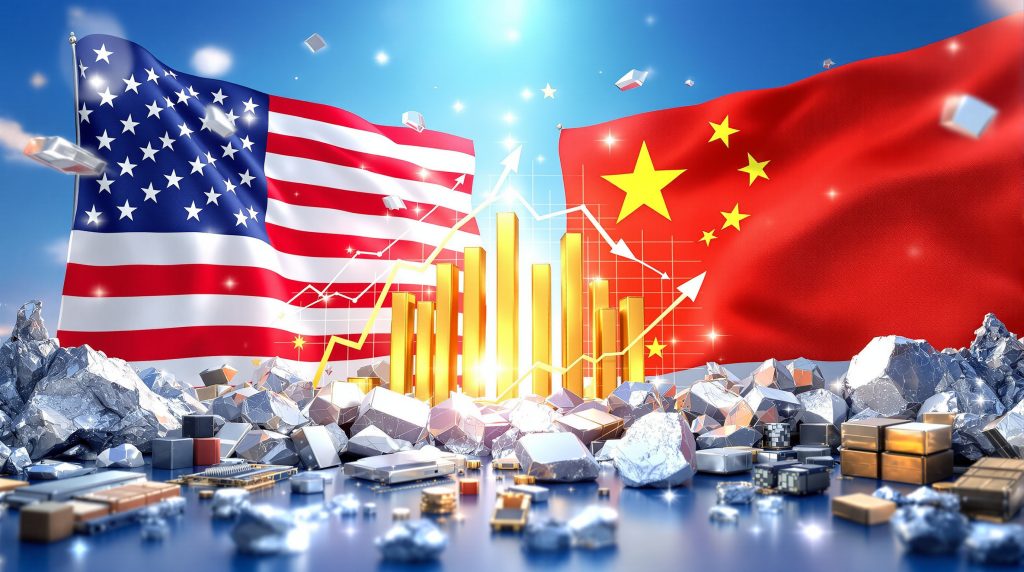The antimony exports trade truce situation continues to evolve as a defining element in US-China trade relations, with market participants closely monitoring diplomatic developments that could significantly alter global supply chains. This metalloid element serves essential functions across defense, electronics, and industrial applications, making its availability a matter of national security and economic stability.
Understanding Antimony's Strategic Importance in Modern Industry
The strategic value of antimony stems from its unique properties as a flame retardant and semiconductor component. Military and defense systems rely heavily on antimony-based compounds to meet stringent fire safety requirements for equipment and electronics. The semiconductor industry utilises antimony in specialised applications where its electrical properties prove irreplaceable.
Industrial manufacturing depends on antimony for glass and ceramic production, where it serves as a clarifying agent and decoloriser. The renewable energy sector increasingly requires antimony compounds for solar panel manufacturing and advanced battery technologies, particularly in next-generation energy storage systems.
Market participants have noted that any disruption to antimony supply chains creates immediate ripple effects across these interconnected industries, highlighting the material's foundational role in modern manufacturing.
Critical Applications Driving Global Demand
China's position as the dominant antimony producer has shaped global supply dynamics for decades. According to industry sources, China controls nearly half of worldwide antimony production, creating significant dependency relationships with importing nations. This concentration of production capacity has left international markets vulnerable to policy changes and geopolitical tensions.
Secondary producers including Russia, Tajikistan, and Bolivia contribute meaningful but limited volumes to global supply. However, their combined output remains insufficient to compensate for potential Chinese supply disruptions, particularly given the technical specifications required by end-user industries.
Western hemisphere production capacity remains notably limited, with most deposits either underdeveloped or operating at reduced capacity due to economic constraints. This geographical imbalance has created structural vulnerabilities that recent export restrictions have exposed with dramatic clarity.
How Did China's Export Controls Transform the Antimony Market?
The evolution of China's antimony export policies represents a masterclass in strategic resource diplomacy, with each policy adjustment creating cascading effects throughout global supply chains. Furthermore, these changes have highlighted the interconnected nature of modern mining industry evolution and trade relationships.
Timeline of Escalating Trade Restrictions
China's approach to antimony export controls followed a deliberate escalation pattern beginning in August 2024. The initial announcement of export licensing requirements represented a shift from unrestricted trade to managed oversight, requiring exporters to provide detailed end-user documentation and obtain government approval.
The December 2024 expansion of restrictions marked a significant escalation, extending controls to antimony, gallium, germanium, and specific graphite types destined for the United States. This policy change occurred strategically one day after the White House imposed new restrictions on high-bandwidth memory chip sales to China, demonstrating the tit-for-tat nature of technological trade disputes.
| Date | Action | Market Impact |
|---|---|---|
| August 2024 | Export licensing requirements announced | Documentation requirements introduced |
| September 15, 2024 | Licensing system implementation | Formal approval processes began |
| December 2024 | US-specific export restrictions | Complete supply disruption to American markets |
| May 2025 | Coordinated enforcement crackdown | Container seizures and port delays intensified |
The May 2025 coordinated crackdown represented the most aggressive enforcement phase, expanding scrutiny to tungsten and rare earth elements while intensifying customs inspections. Even previously unrestricted materials like antimony masterbatches found themselves subject to port reviews and extended delays.
Market Response to Supply Chain Disruptions
The market response to these escalating restrictions revealed the fragility of global antimony supply chains. Container shipments experienced delays lasting months, with exporters reporting that several containers remained held at Chinese ports with only occasional clearances.
According to Fastmarkets, "A container of antimony trioxide held since March 2025 finally received clearance for delivery to South Korea in early November, representing one of the few documented successful shipments during the restriction period."
The business impact proved severe, with most Chinese antimony exporters suspending overseas operations entirely. This unprecedented disruption forced international buyers to explore alternative sourcing arrangements with Pakistan and other producing nations, though at significantly higher costs and with uncertain supply reliability.
Consequently, price volatility emerged as a defining characteristic of the restricted market environment, creating challenges for manufacturers dependent on stable antimony pricing for production planning and cost management.
What Changed Following the November 2025 US-China Summit?
The November 2025 meeting between US President Donald Trump and Chinese President Xi Jinping marked the first face-to-face diplomatic engagement between the leaders since 2019, generating significant speculation about potential changes to antimony export policies.
Market Expectations and Policy Uncertainty
Despite widespread hopes for policy modifications, the immediate aftermath of the summit revealed continued uncertainty regarding antimony exports trade truce implementation. As of November 6, 2025, China had made no official announcement regarding changes to antimony export restrictions, leaving market participants in a state of cautious anticipation.
The range of market sentiment reflected the complexity of the situation, with speculation spanning from complete policy reversal to the introduction of managed quota systems. Some participants focused on potential macro and microeconomic consequences, while others remained sceptical about any substantial changes to China's strategic mineral export approach.
Implementation Challenges and Ongoing Negotiations
Industry sources indicated that the two sides might still be negotiating implementation details, suggesting that any eventual policy changes would require careful structuring to address both nations' strategic concerns. In addition, the complexity of these negotiations reflects the broader technological competition between the United States and China.
"Nothing remains certain until formal policy documents are published and implemented," noted one market participant, reflecting the lessons learned from previous policy announcements that failed to materialise as expected.
The partial clearing of some containers, including the antimony trioxide shipment held since March, suggested possible slight easing of enforcement intensity. However, participants cautioned against reading too much into isolated incidents.
Which Industries Will Benefit Most from Resumed Antimony Trade?
The potential resumption of antimony exports trade truce would create differentiated benefits across industrial sectors, with some industries experiencing more immediate relief than others based on their specific antimony requirements and inventory positions.
Defense and Aerospace Sector Recovery
Military applications represent perhaps the most critical category for antimony supply restoration. Defense contractors require antimony-based flame retardants for electronic systems, aircraft components, and specialised equipment that must meet stringent safety specifications.
The aerospace industry's dependence on antimony extends beyond flame retardancy to include specific metallurgical applications where substitution proves technically challenging or prohibitively expensive. Supply chain stability for these applications carries national security implications that extend beyond purely economic considerations.
Current supply disruptions have forced defense contractors to explore alternative materials and suppliers, though many of these solutions provide only temporary relief while compromising performance specifications or increasing costs substantially.
Consumer Electronics and Technology Manufacturing
Semiconductor manufacturing represents another critical application area where antimony supply restoration would provide immediate benefits. The electronics industry requires antimony compounds for specialised semiconductor applications where the material's unique electrical properties prove irreplaceable.
Battery technology development, particularly for electric vehicles and energy storage systems, depends on antimony for certain advanced chemistries that promise improved performance characteristics. The renewable energy transition has increased demand for these specialised applications, making supply reliability increasingly important.
Solar panel manufacturing utilises antimony-based materials in specific production processes, linking antimony availability to the broader clean energy transition. Any supply disruption in this sector creates cascading effects throughout renewable energy project development timelines.
Industrial Manufacturing Applications
Glass and ceramic production industries maintain steady demand for antimony as a clarifying agent and decoloriser. While these applications may seem less critical than defence or technology uses, they represent significant volume demand that supports the economic viability of antimony production operations.
Industrial applications often provide the foundational demand that enables mining operations to maintain consistent production levels, supporting supply availability for more specialised military and technology applications.
How Are Companies Adapting Their Supply Chain Strategies?
The antimony supply disruption has forced companies across affected industries to fundamentally reconsider their sourcing strategies and supply chain risk management approaches. This situation underscores the importance of having a well-structured critical minerals reserve strategy.
Diversification Efforts Beyond China
Market participants have accelerated efforts to identify and qualify alternative antimony suppliers outside China, though these efforts face significant technical and economic challenges. Pakistan has emerged as a potential alternative source, with companies exploring partnership agreements for antimony mining and processing operations.
Alternative sourcing initiatives include:
- Exploration partnerships with Pakistani mining companies for antimony deposit development
- Technology transfer agreements to establish processing capabilities in alternative locations
- Joint venture structures to reduce capital requirements for new supply chain development
- Long-term purchase agreements to provide investment security for alternative producers
North American deposit evaluation has intensified, with companies reassessing previously uneconomical antimony resources given current price levels and supply security concerns. Australian mining companies have also reported increased interest in their antimony projects from international buyers seeking supply diversification.
Risk Management and Strategic Planning
Companies have implemented sophisticated risk management strategies to navigate the uncertain policy environment. Strategic inventory management has become a critical capability, with companies balancing carrying costs against supply disruption risks.
Multiple supplier qualification processes now represent standard practice, even when alternative sources offer higher costs or lower quality specifications. Companies recognise that supply security often justifies premium pricing, particularly for critical applications where substitution proves impossible.
Price hedging mechanisms have gained importance as antimony price volatility increased dramatically during the restriction period. Financial instruments that previously seemed unnecessary now provide essential risk mitigation for companies with significant antimony exposure.
Technology development for recycling and material substitution has accelerated, with companies investing in research and development programmes that previously received limited attention. These initiatives provide long-term supply security while reducing dependence on primary mining operations.
What Does This Mean for Future Trade Relations?
The antimony export restrictions represent a fundamental shift in how strategic materials function within international trade relationships, with implications extending far beyond the immediate supply chain disruptions. The broader US-China trade impact continues to shape global economic relationships.
Strategic Mineral Diplomacy Evolution
Critical materials have emerged as powerful tools for international negotiations, with countries increasingly recognising the leverage provided by control over essential industrial inputs. The antimony situation demonstrates how relatively small markets can create disproportionate geopolitical influence when materials prove strategically important.
National security considerations now play increasingly prominent roles in trade policy decisions, with both the United States and China viewing critical mineral access through security rather than purely economic lenses. This shift suggests that future trade disputes may increasingly involve strategic materials as both weapons and objectives.
International cooperation frameworks for critical minerals are evolving rapidly, with allied nations exploring resource sharing agreements and coordinated development strategies. These initiatives aim to reduce collective dependence on potentially adversarial suppliers whilst maintaining access to essential materials.
Implications for Global Mining Investment
Investment patterns in antimony mining and processing have shifted dramatically in response to supply security concerns. Capital allocation increasingly favours projects outside China, even when economic returns appear less attractive than historical Chinese investments.
Key investment trends include:
- Government incentives for domestic critical mineral production capacity development
- Private capital flowing toward previously marginal antimony deposits in friendly jurisdictions
- Technology investment in processing capabilities to reduce dependence on Chinese facilities
- Environmental standards becoming competitive advantages for Western antimony producers
Environmental and social governance considerations have gained prominence in antimony sourcing decisions, with companies increasingly willing to pay premiums for materials produced under acceptable ESG standards. This trend provides competitive advantages for producers in jurisdictions with strong environmental and labour regulations.
Technology transfer agreements have become common structures for developing alternative supply chains, with established mining companies partnering with new entrants to accelerate project development timelines. These partnerships often include knowledge sharing, equipment provision, and market access arrangements.
Investment Implications for Antimony-Related Sectors
The evolving antimony supply landscape creates distinct investment opportunities and risks across multiple sectors, with market participants repositioning portfolios to capitalise on structural changes. Furthermore, recent developments like the strategic antimony loan demonstrate government commitment to supply chain security.
Mining Companies Positioned for Growth
Existing antimony producers outside China have experienced dramatic improvements in their competitive positions, with some companies reporting increased customer interest and improved pricing power. These companies benefit from proximity advantages and reduced geopolitical risk profiles.
Exploration companies with identified antimony deposits have attracted significant investor attention, particularly those located in politically stable jurisdictions with established mining infrastructure. Early-stage development projects that previously struggled for financing now find receptive investor audiences.
Processing technology firms specialising in antimony refinement and purification have emerged as critical bottlenecks in alternative supply chain development. Companies providing these services command premium valuations and strategic partnership opportunities.
Recycling operations for antimony recovery from electronic waste and industrial byproducts have gained economic viability as primary supply constraints increase prices. These operations provide both environmental benefits and supply security advantages.
End-User Industry Considerations
Electronics manufacturers face complex decisions regarding inventory management, supplier qualification, and long-term sourcing strategies. Companies with diversified supply bases demonstrate improved resilience compared to those heavily dependent on Chinese antimony.
Defense contractors must balance cost considerations against supply security requirements, with many accepting higher material costs to ensure uninterrupted access to critical antimony supplies. Government support for domestic supply chain development often helps offset these increased costs.
Renewable energy companies increasingly factor antimony availability into project planning and technology selection processes. Supply chain visibility has become a competitive advantage in securing project financing and customer commitments.
Additionally, the recent critical minerals order has created new regulatory frameworks that affect how companies approach strategic material sourcing and inventory management.
### How Will Policy Changes Shape the Market?
The antimony exports trade truce remains subject to ongoing diplomatic negotiations and policy adjustments. According to CNBC, recent developments suggest potential modifications to export restrictions, though market participants remain cautious about celebrating premature policy changes.
Companies continue to monitor regulatory developments whilst building resilient supply chains that can withstand future policy volatility. The experience has taught valuable lessons about the importance of supply diversification and strategic planning in critical material procurement.
Disclaimer: This analysis reflects market conditions and policy information available as of November 2025. Trade policy developments, pricing data, and supply chain arrangements remain subject to rapid change based on ongoing diplomatic negotiations and market forces. Investors should conduct independent research and consult qualified advisors before making investment decisions based on critical mineral supply chain considerations.
The antimony exports trade truce situation continues to evolve, with market participants closely monitoring diplomatic developments and policy announcements that could significantly alter the strategic mineral landscape. Understanding these dynamics requires ongoing analysis of both technical market factors and broader geopolitical trends affecting critical material supply chains.
Ready to Capitalise on Critical Minerals Market Opportunities?
Discovery Alert's proprietary Discovery IQ model delivers real-time alerts on significant ASX mineral discoveries, instantly empowering subscribers to identify actionable opportunities in critical minerals and strategic materials ahead of the broader market. With antimony and other critical minerals gaining strategic importance, discover why historic mineral discoveries can generate substantial returns and begin your 30-day free trial today to position yourself ahead of evolving market dynamics.




